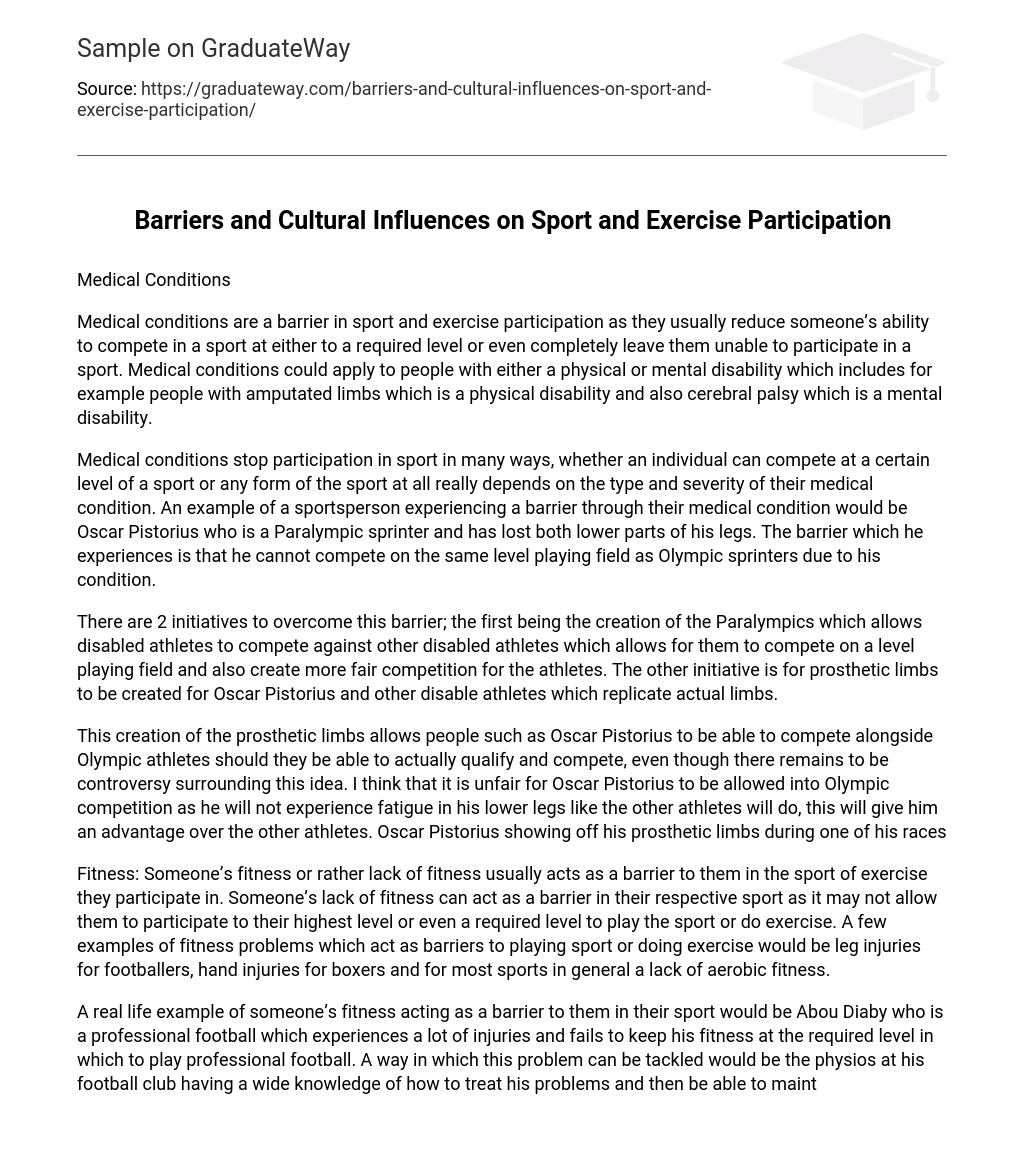Medical Conditions
Individuals with medical conditions may face obstacles in participating in sports and exercise, either due to limitations on their competitive ability or complete inability to participate. Such conditions can include physical disabilities like limb loss or mental disabilities such as cerebral palsy.
Various medical conditions can hinder individuals’ involvement in sports in different ways. The extent to which they can participate or engage in any sport relies on the nature and severity of their ailment. Oscar Pistorius, a Paralympic athlete with amputated lower legs, serves as an example of a competitor who encounters challenges due to his medical condition. His condition inhibits him from competing at the same level as Olympic sprinters.
Two initiatives aim to tackle this challenge. The first one is the establishment of the Paralympics, which enables disabled athletes to compete against each other on a level playing field, ensuring fairness and equality in competition. The second initiative involves the development of prosthetic limbs specifically designed for disabled athletes like Oscar Pistorius, closely resembling natural limbs.
The use of prosthetic limbs in the Olympics has sparked controversy, as individuals like Oscar Pistorius are allowed to compete if they meet requirements. However, I personally believe it is unfair for Pistorius to participate because his lower legs do not tire like those of other athletes, giving him an advantage. In one of his races, Pistorius displayed his prosthetic limbs.
The significance of fitness in sports and exercise should not be underestimated. It can impede individuals’ involvement in their preferred activities and prevent them from performing optimally or meeting the necessary level of participation. For instance, footballers with leg injuries, boxers with hand injuries, and those with low aerobic fitness may struggle to engage in sports or exercise.
A real-life example of a person’s fitness serving as a hindrance to their sport is Abou Diaby, a professional football player who frequently suffers from injuries and finds it challenging to maintain the necessary fitness level for professional football. To address this issue, the physiotherapists at his football club must possess extensive knowledge in treating his injuries and assisting him in maintaining his fitness once he attains the required level for professional play.
Resources
The lack of resources can hinder sports participation as certain sports necessitate specific equipment. To illustrate, football requires a football, while tennis demands two rackets and a ball. Without the essential gear, one cannot engage in the sport. Such obstacles may affect numerous individuals globally, particularly those from impoverished backgrounds who cannot afford the necessary resources. Additionally, lower-level sports clubs lacking funding may also be impacted by resource scarcity, unable to acquire and sustain their equipment.
An initiative has been implemented by the Football Association (FA) to provide financial assistance to lower-level football clubs. Through this initiative, clubs can apply for funding from the FA to improve their facilities and promote participation in football, particularly among younger generations.
The cultural influence chosen has a profound effect on sports, especially regarding racial hatred and discrimination. While this group engages in various sports, black individuals tend to excel in sports that necessitate explosive speed, power, and height. Sports like sprinting events such as the 100m, basketball, and boxing exemplify this demand for a combination of these physical qualities.
It is observed that black individuals often achieve great success in specific sports, attributing this to their genetic composition that provides them an edge over individuals from different ethnic backgrounds. Consequently, the prevalence of highly skilled black athletes in these sports may demotivate others from participating due to feeling intimidated. The considerable presence of talented black competitors might lead to a perception that success is unlikely for those without a genetic predisposition for excelling in that particular sport.
The underrepresentation of white individuals in basketball can exemplify the impact of cultural influences. This phenomenon arises from multiple factors, encompassing perceived physical disadvantages and apprehension stemming from the predominance of black players in the NBA. Furthermore, the limited presence of white players amplifies skepticism regarding their aptitude and prospects in the sport, discouraging their participation in basketball altogether.
The statistics of African and Caucasian individuals who participate in certain NBA teams are presented in the table below. There is a clear difference in the number of African and Caucasian individuals.
References
-
http://www.thefa.com/my-football/football-volunteers/runningaclub/yourfacilities/funding
– Funding for Your Facilities: This website provides information on funding opportunities for football clubs.





